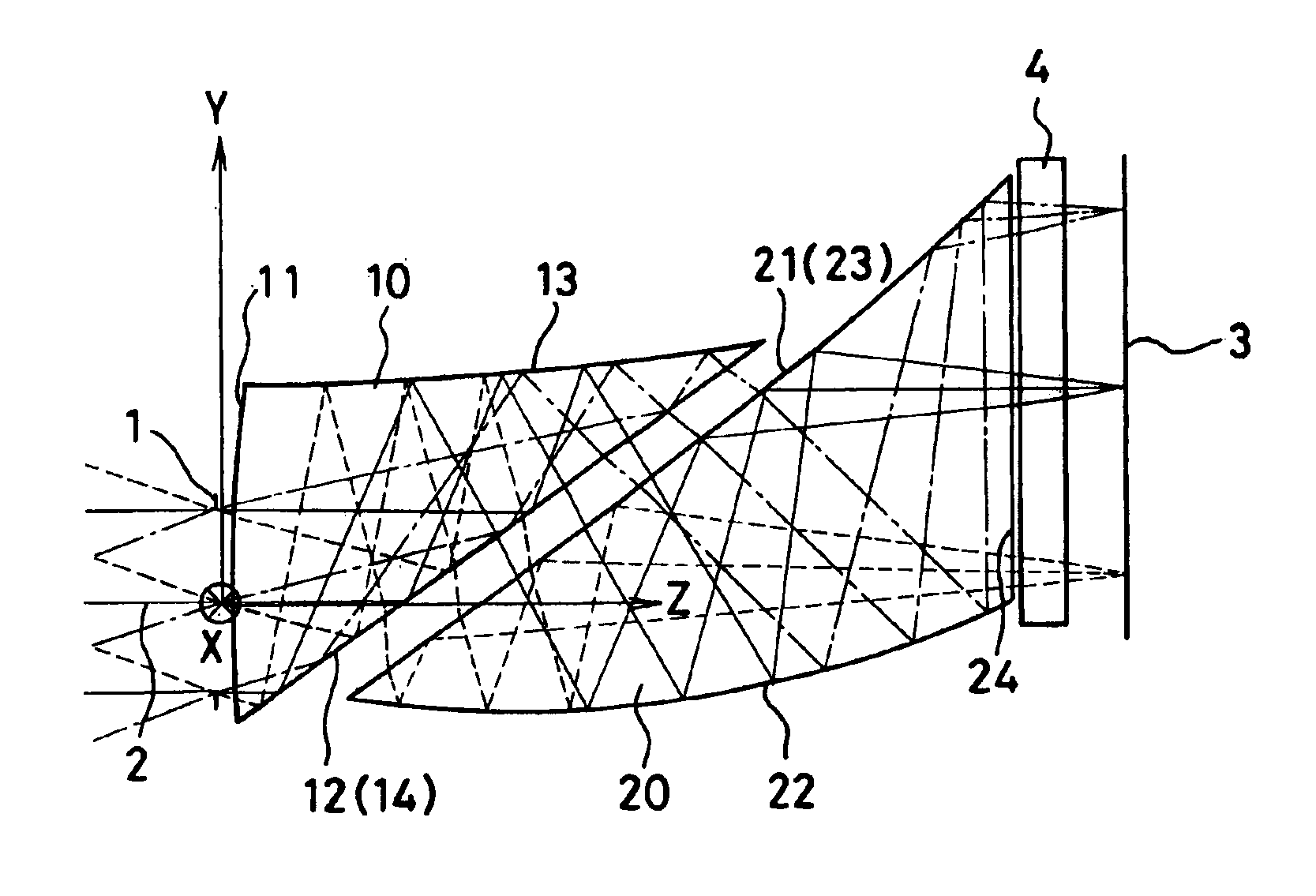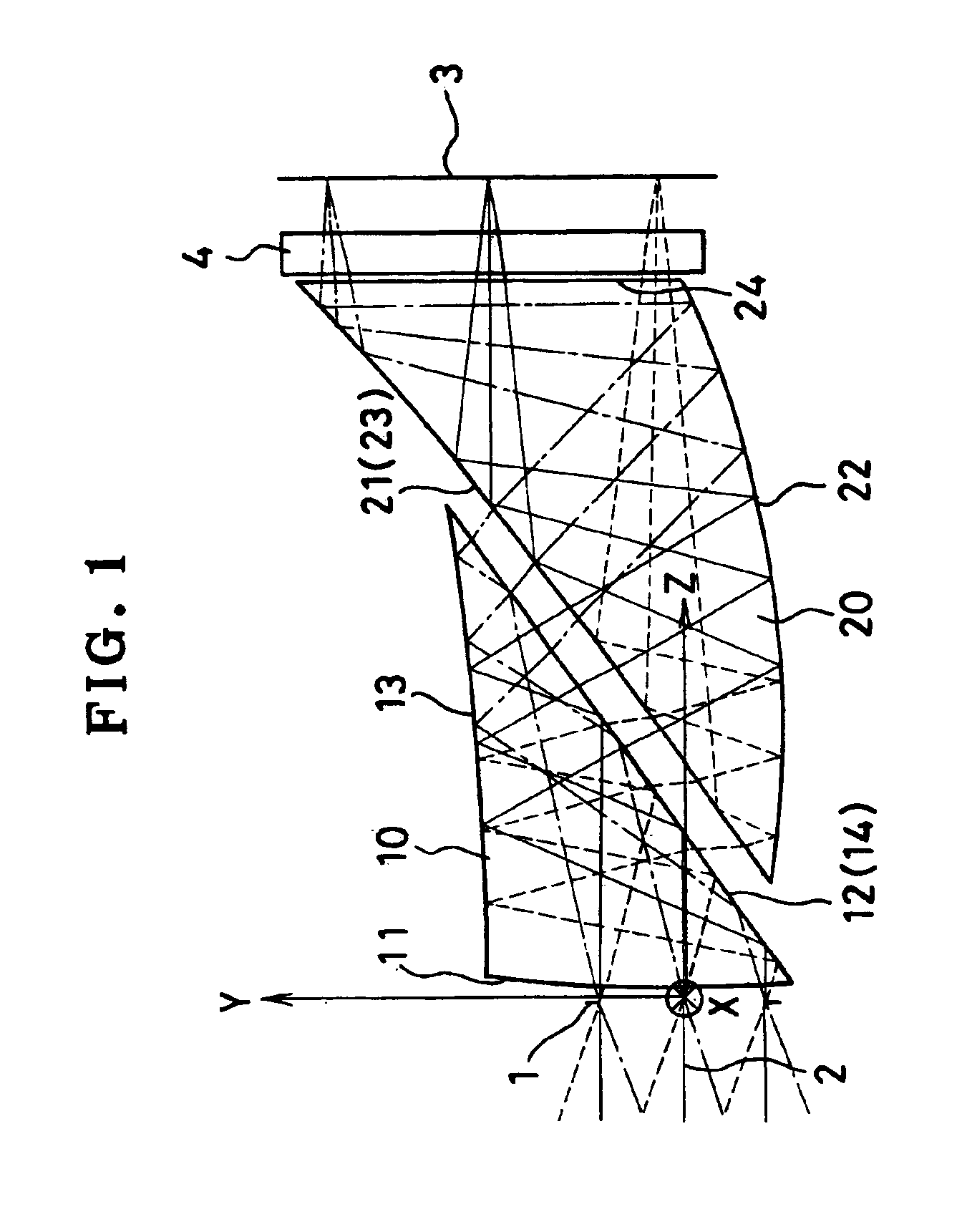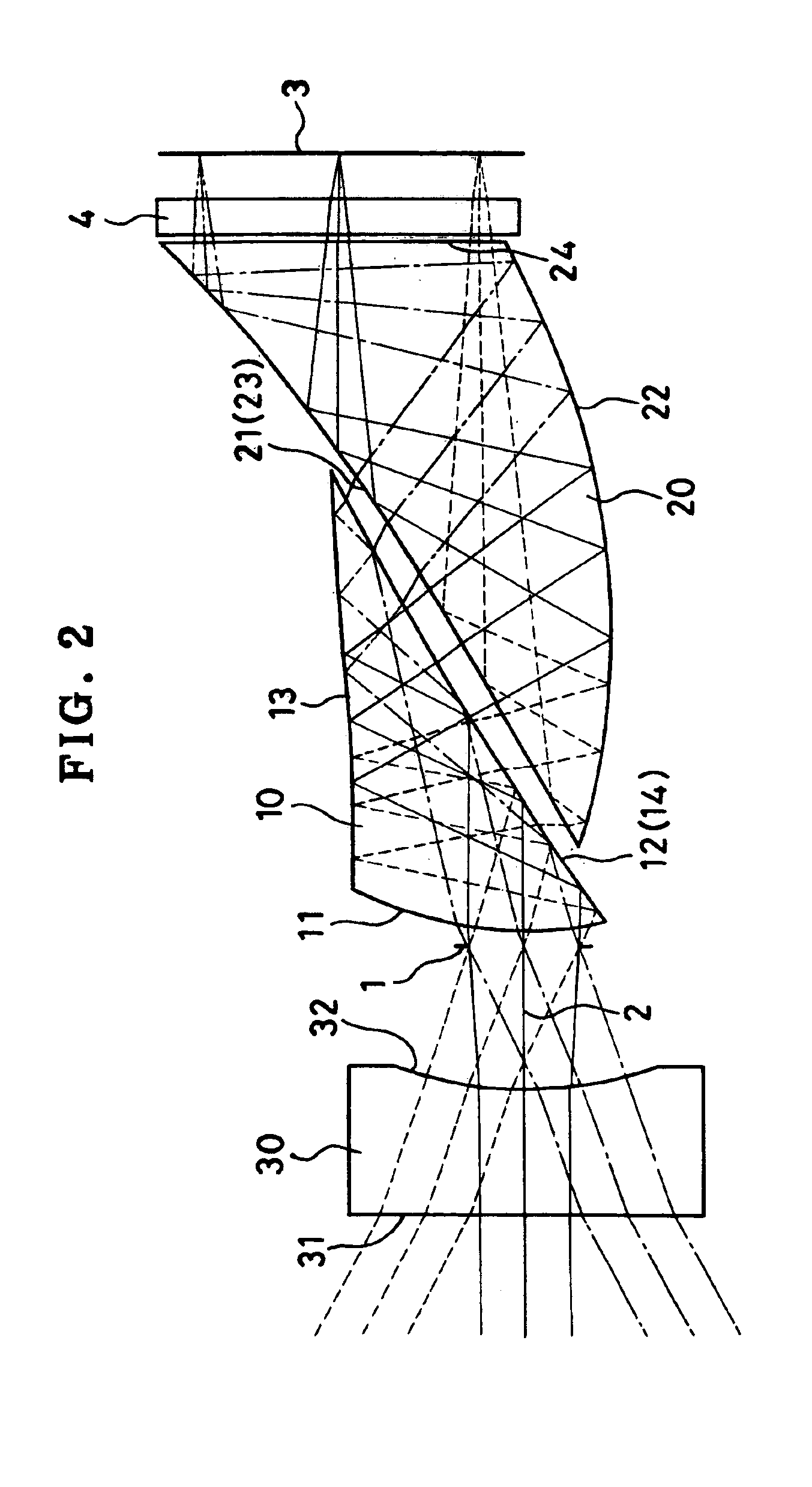Image-forming optical system
- Summary
- Abstract
- Description
- Claims
- Application Information
AI Technical Summary
Benefits of technology
Problems solved by technology
Method used
Image
Examples
examples 1 and 2
of the image-forming optical system according to the present invention will be described below.
Constituent parameters of Examples 1 and 2 will be shown later. In the constituent parameters, surface Nos. are shown as surface Nos. in forward ray tracing from an object through a stop 1 to an image plane 3. Regarding the definition of coordinates, as shown in FIG. 1, an axial principal ray 2 is defined by a light ray passing through the center of the stop 1 and reaching the center of the image plane 3 (the image pickup surface of an image pickup device). An intersection between the axial principal ray 2 and the plane of the stop 1 is defined as the origin of a decentered optical surface. The direction along the axial principal ray 2 is defined as a positive direction of a Z-axis. A plane containing both the Z-axis and the center of the image plane 3 is defined as a YZ-plane. An axis passing through the origin and perpendicularly intersecting the YZ-plane is defined as an X-axis. The dir...
example 1
SurfaceRadius ofSurfaceDisplacementRefractiveAbbe'sNo.curvatureseparationand tiltindexNo.Object∞∞plane1∞ (Stop)2FFS①(1)1.525455.83FFS②(2)1.525455.84FFS③(3)1.525455.85FFS②(2)6FFS④(4)1.525455.87FFS⑤(5)1.525455.88FFS④(4)1.525455.89∞(6)10∞(7)1.516364.111∞(8)Image∞(9)planeFFS①C4 5.4038 × 10−2C6 1.8678 × 10−2FFS②C4 1.2719 × 10−3C6−2.0180 × 10−3C8 6.9200 × 10−4C10−3.2115 × 10−4C11−1.7770 × 10−4C13 9.7017 × 10−5C15−1.5867 × 10−5FFS③C4−1.7204 × 10−2C6−1.1421 × 10−2C8 2.6819 × 10−3C10−6.9701 × 10−4C11−3.2922 × 10−4C13 1.9243 × 10−4C15−3.7214 × 10−5FFS④C4−2.3174 × 10−2C6−4.5848 × 10−3C8−2.2925 × 10−4C10−5.4406 × 10−4C11 1.7325 × 10−4C13−4.0761 × 10−6C15−3.7446 × 10−5FFS⑤C4−4.5549 × 10−2C6−3.5862 × 10−2C8 1.0022 × 10−3C10−3.1292 × 10−4C11−1.0085 × 10−4C13−1.7098 × 10−4C15−5.5848 × 10−6Displacement and tilt(1)X0.00Y0.00Z0.20α0.00β0.00γ0.00Displacement and tilt(2)X0.00Y−0.00Z2.37α−56.36β0.00γ0.00Displacement and tilt(3)X0.00Y...
example 2
SurfaceRadius ofSurfaceDisplacementRefractiveAbbe'sNo.curvatureseparationand tiltindexNo.Object∞∞plane1ASS①2.001.525455.825.322.323∞ (Stop)4FFS①(1)1.525455.85FFS②(2)1.525455.86FFS③(3)1.525455.87FFS②(2)8FFS④(4)1.525455.89FFS⑤(5)1.525455.810FFS④(4)1.525455.811∞(6)12∞(7)1.516364.113∞(8)Image∞(9)planeASS①R−0.19K−5.3042 × 1012A 3.2263 × 10−4B 9.4407 × 10−6FFS①C4 9.4601 × 10−2C6 9.4063 × 10−2FFS②C4 7.0060 × 10−3C6 3.4313 × 10−3C8 4.4086 × 10−4C10 4.1181 × 10−4C11 3.8467 × 10−4C13−8.7750 × 10−6C15 2.3939 × 10−5FFS③C4−1.0899 × 10−2C6−1.1224 × 10−2C8 2.4936 × 10−3C10 2.7277 × 10−3C11 1.4602 × 10−5C13−3.1706 × 10−4C15 6.5358 × 10−5FFS④C4−3.6243 × 10−2C6−1.6563 × 10−2C8−2.2006 × 10−3C10−1.5026 × 10−3C11 2.4606 × 10−4C13−9.1150 × 10−5C15−6.4463 × 10−5FFS⑤C4−5.0002 × 10−2C6−4.1129 × 10−2C8 3.4936 × 10−4C10 1.8044 × 10−4C11−1.1817 × 10−4C13−2.3358 × 10−4C15−4.8676 × 10−5Displacement and tilt(1)X0.00Y0.00Z0.20α0.00...
PUM
 Login to view more
Login to view more Abstract
Description
Claims
Application Information
 Login to view more
Login to view more - R&D Engineer
- R&D Manager
- IP Professional
- Industry Leading Data Capabilities
- Powerful AI technology
- Patent DNA Extraction
Browse by: Latest US Patents, China's latest patents, Technical Efficacy Thesaurus, Application Domain, Technology Topic.
© 2024 PatSnap. All rights reserved.Legal|Privacy policy|Modern Slavery Act Transparency Statement|Sitemap



